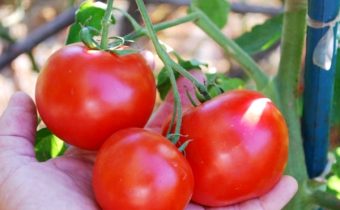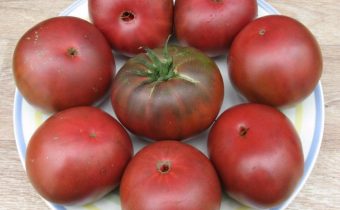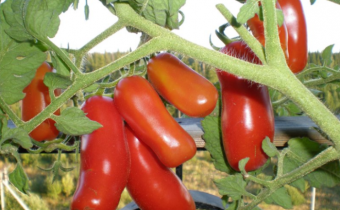How to get rid of slugs on tomatoes, once and for all?
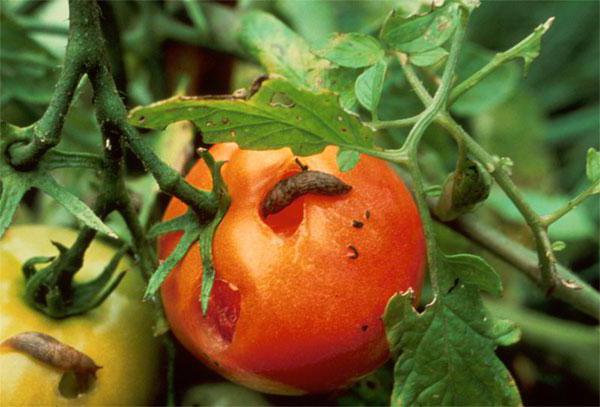
In conditions of high humidity, tomatoes can be subject to attack by slugs. Pests are not so easy to detect, and the damage they cause is a further cause of poor harvest. Slugs can and should be fought, it is only important to determine the right methods for their eradication.
Description and Symptoms
 Slugs are mollusks that have an elongated bare body up to 4-5 centimeters long. It feeds the pest in the main plant mass - leaves, stem and fruits. He attacks not only tomatoes, but also other crops: peppers, zucchini, eggplants, cucumbers. From it remains a characteristic trail - secreted mucus.
Slugs are mollusks that have an elongated bare body up to 4-5 centimeters long. It feeds the pest in the main plant mass - leaves, stem and fruits. He attacks not only tomatoes, but also other crops: peppers, zucchini, eggplants, cucumbers. From it remains a characteristic trail - secreted mucus.
The habitat of slugs is a shaded part of the garden, where humidity is increased. When damp, mollusks begin to actively proliferate, their population increases significantly. Slugs can hide under rusty buckets, wet firewood and logs. When the weather is hot, activity noticeably decreases, pests become passive and do not leave the shelter.
The most frequent representative is reticulated slug. It has a brown color of the calf, its length reaches 3 centimeters. He attacks tomatoes at night, gnaws holes in the leaves; if there is fruit, he eats their flesh.
Holes on leaves from slugs are sometimes confused as from caterpillars. The difference lies in the size of the holes (they are larger from the slugs) and in the presence of silvery mucus on the foliage.
The period of activity begins with temperature warming and falls on the end of spring. The rainy season or the cold summer can aggravate the problem, for mollusks such weather is considered the most favorable.
Recognize pests can be on several grounds:
- the appearance of large holes and a slimy texture on the leaves;
- high humidity on the street or in the greenhouse;
- tomato bushes slow down in growth, flower stalks fall off.
The presence of these signs indicates the presence of parasites in the garden, with which you need to immediately fight.
Harm
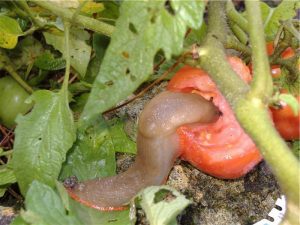 Slugs are carriers of infection. They spread fungi and viruses, often after they are attacked, tomatoes fall ill with powdery mildew, sulfur or brown rot, blight. As a result, the plant is doomed to further death.
Slugs are carriers of infection. They spread fungi and viruses, often after they are attacked, tomatoes fall ill with powdery mildew, sulfur or brown rot, blight. As a result, the plant is doomed to further death.
Insects reduce the immune ability of the crop, spoil the appearance and significantly slow down the formation of the crop. Fruits that have already been attacked by pests are not suitable for human consumption, they can be infected and have an unattractive appearance. It is necessary to get rid of them.
Pest control
There are several ways to fight. All of them are effective in their own way and are aimed at destruction.
Mechanical method
It is considered the most time consuming, but effective. Slugs need to be collected by hand at night. At 1-2 o'clock in the morning they approach tomatoes, on which mucus spots have already been observed, they shine with a lantern and remove the parasites in the can. Then the jar is closed with a lid and disposed of, you can burn the contents.
Biological method
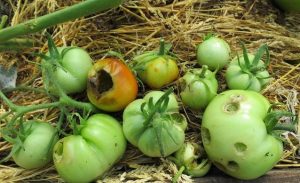 Slugs are afraid of parasitic nematodes. It is sold in the form of a biological supplement, which consists of living microorganisms. The nematode does not harm tomatoes and the human body, so it can be applied without fear. Microorganisms are diluted in water (1 tablespoon per 10 liters) and watered the soil around tomatoes from a watering can.In a week, the slugs will be gone.
Slugs are afraid of parasitic nematodes. It is sold in the form of a biological supplement, which consists of living microorganisms. The nematode does not harm tomatoes and the human body, so it can be applied without fear. Microorganisms are diluted in water (1 tablespoon per 10 liters) and watered the soil around tomatoes from a watering can.In a week, the slugs will be gone.
Chemical method
The principle of action is based on the use of chemicals - substances that poison pests. The main component of additives is metaldehyde. It is poison, so you need to work only with gloves. Preparations containing metaldehyde are sold in garden supplies. They are diluted in water to the condition indicated on the package and treated with soil or foliage.
When processing it is desirable not to fall on the fruit, otherwise they will be poisoned by poison.
Folk ways
Like most pests, slugs do not tolerate harsh odors. This fact can be used and make an effective means to fight. Spray tomatoes with a solution of ammonia. Mix 4 tablespoons of alcohol in a bucket of water. Spray a mixture of bushes and repeat treatment every 3-4 days for 2 weeks.
In addition to liquid ammonia, you can use onion peel decoction. Husk from 2-3 medium bulbs steamed in boiling water and insist 2-3 days. Then filter the solution and irrigate the tomatoes infusion in the evening. For greater efficiency, it is recommended to add a tablespoon of household soap to any product.
Prevention
 Slugs are not as common in the garden, but their appearance can be avoided if:
Slugs are not as common in the garden, but their appearance can be avoided if:
- Loosen the soil regularly and treat it before planting with any insecticidal additive.
- Do not abuse with watering, but do it when the soil is completely dry.
- Do not conduct watering in the evening and in rainy weather. After moistening the ground in the greenhouse, reduce the humidity: open the vents and doors.
- Plant garlic or onions between rows. You can expand the cut nettles.
In addition, the tomatoes themselves after transplantation into open ground, can be sprayed with an infusion of hot pepper and mustard, prepared according to the following recipe:
- a glass of chili pepper;
- 2 tbsp. mustard;
- a bucket of water.
Mix the ingredients and irrigate the tomatoes, pour a solution of soil near the roots. The first treatment is carried out 2 weeks after transplanting seedlings. In addition to effectively combating slugs, the infusion reduces the risk of viral diseases and discourages other insects6 from aphids, ants, beetles and caterpillars.
Tomatoes can be processed with a coffee solution with a concentration of 0.01%. It has a pleasant smell, and it causes hostility among pests. The tool is used even during fruiting, because it does not harm the fruit.
The fight against slugs is most often resolved in a positive direction - their total eradication from the garden. Pests are easy to destroy, if you take action at the very beginning, the code began to show the first signs. If the situation gets out of control, then getting rid of pests becomes much more difficult. With a timely response, slugs do not affect the quality of tomatoes and the development of plants in general.



